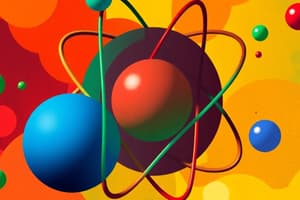Podcast
Questions and Answers
Who proposed that matter is made up of tiny, indivisible particles called atomos?
Who proposed that matter is made up of tiny, indivisible particles called atomos?
- Ernest Rutherford
- Democritus (correct)
- John Dalton
- Aristotle
What was Aristotle's contribution to the understanding of matter?
What was Aristotle's contribution to the understanding of matter?
- Matter is made of isotopes
- Matter consists solely of electrons
- Matter is composed of four elements (correct)
- Matter is made of atoms
Which of the following statements is part of John Dalton's Atomic Theory?
Which of the following statements is part of John Dalton's Atomic Theory?
- All atoms of a given element have different masses.
- Atoms of different elements form compounds. (correct)
- Atoms are not indivisible.
- All atoms can be destroyed.
Who discovered the electron through experiments with cathode rays?
Who discovered the electron through experiments with cathode rays?
What did Ernest Rutherford discover during his alpha-scattering experiments?
What did Ernest Rutherford discover during his alpha-scattering experiments?
Which sub-atomic particle is represented in the Nuclear Model as discovered by Rutherford?
Which sub-atomic particle is represented in the Nuclear Model as discovered by Rutherford?
What key aspect of the atomic model did James Chadwick contribute?
What key aspect of the atomic model did James Chadwick contribute?
What was one of Dalton's statements regarding atoms?
What was one of Dalton's statements regarding atoms?
Flashcards are hidden until you start studying
Study Notes
Foundations of Atomic Theory
- Democritus proposed the concept of atoms (atomos) as indivisible particles forming matter.
- Aristotle countered Democritus, suggesting matter comprised four elements, significantly influencing the Church's views on matter.
John Dalton's Atomic Theory
- Established four foundational postulates about atoms:
- All matter consists of indivisible and indestructible atoms.
- Atoms of a specific element are identical in mass and properties, leading to the concept of isotopes.
- Compounds are formed when two or more different types of atoms combine.
- Chemical reactions entail the rearrangement of atoms.
Evolution of Atom Structure
- JJ Thomson discovered the electron through cathode ray experiments, indicating the presence of subatomic particles.
- Ernest Rutherford discovered the proton via the alpha-scattering experiment, which led to the nuclear model of the atom.
Subatomic Particles and Atomic Models
- Initial models of the atom, including early computations regarding subatomic particle masses, were later refined.
- James Chadwick conducted further experiments that led to the discovery of the neutron, completing the understanding of atomic structure.
Educational Activity
- Create a timeline on the history of atomic theory showcasing:
- Names and drawings of atomic models in 3D.
- Names of discoverers.
- Significant years in atomic discoveries, from Dalton's work to Chadwick's advancements.
- Encourage creative presentation, emphasizing the development of the atomic model over time.
Studying That Suits You
Use AI to generate personalized quizzes and flashcards to suit your learning preferences.




